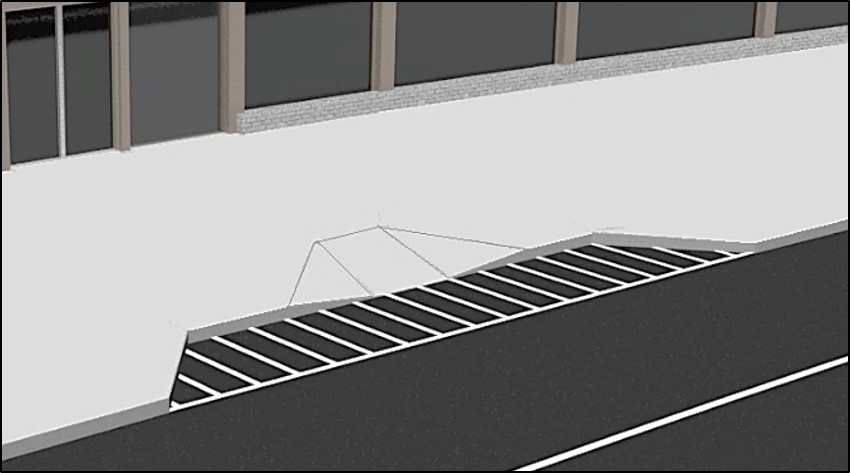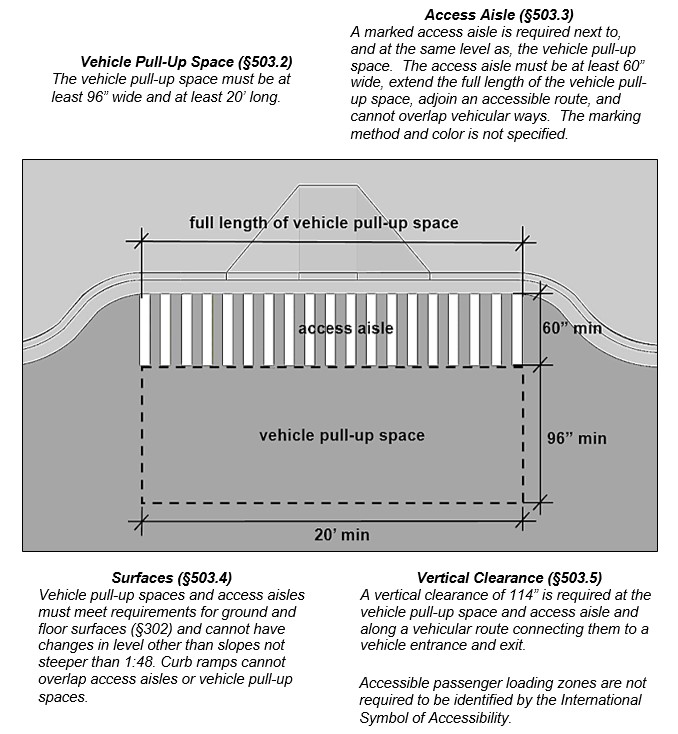This guide explains requirements in the ADA Standards for passenger loading zones.
Notational tips for users of screen reading software follow. In this document ″ indicates inches and ′ indicates feet. Some images are paired with visually hidden notes. These annotations are prefaced with begin and end image notes.
Required Compliance
[§209]
Where passenger loading zones are provided, at least one accessible passenger loading zone is required in every continuous 100 linear feet of loading zone or fraction thereof. Compliance is required only where areas are specifically designed or designated for passenger loading, such as those at airports, many hotels, and convention centers.

At least 1 accessible passenger loading zone is required in every continuous 100 linear feet (or fraction) of passenger loading zone space.
Required Passenger Loading Zones

Accessible passenger loading zones must be provided at these facilities, whether or not passenger loading zones are planned:
- licensed medical care and licensed long term care facilities where the period of stay exceeds 24 hours (located at an accessible entrance) (§209.3);
- parking facilities where valet parking service is provided (§209.4); and
- mechanical access parking garages (located at vehicle pick-up and drop-off areas) (§209.5)
Accessible Passenger Loading Zones
[§503]
Requirements for accessible passenger loading zones address vehicle pull-up spaces and access aisles, including their dimensions, surfacing, and vertical clearance.

Bus Loading Areas and On-Street Bus Stops
[§209.2.2]
Loading zones designed for buses that provide general or special service, including charter service, to the public on a regular and continuing basis are required to comply with provisions for bus boarding and alighting areas (§810.2) in the transportation facility section of the Standards. This includes bus service provided by public transit agencies and other state or local government entities, excluding public school transportation (referred to as “designated public transportation” in ADA regulations issued by the Department of Transportation (DOT)). It also applies to those serving tour, charter, and shuttle buses operated by private entities (referred to as “specified public transportation” in DOT’s regulations). On-street bus stops also must comply with requirements in §810.2 to the maximum extent practicable.
Common Questions

Are accessible passenger loading zones required on sites where no passenger loading zone is intended?
Accessible passenger loading zones are required at these sites whether or not passenger loading zones are planned: parking facilities that provide valet parking, licensed medical care and long term care facilities where the period of stay exceeds 24 hours, and mechanical access parking garages. At all other facilities, the requirements apply only where passenger loading zones are provided.
What constitutes a “passenger loading zone”?
Only those areas that are specifically designed or designated for passenger loading are considered “passenger loading zones” under the Standards. This includes those passenger drop-off or pick-up areas commonly found at airports, convention centers, schools, and many hotel entrances that have design features, signs, or markings indicating passenger loading zones. At other locations, compliance is not required even if passenger loading may occasionally occur, but is not specifically intended or reflected in the design.
What distinguishes passenger loading zones from bus loading zones?
Requirements for passenger loading zones (§209.2.1) apply to any passenger loading areas except those that exclusively serve buses providing designated or specified public transportation as defined by DOT’s ADA regulations, including charter service, which are subject to criteria for bus loading zones (§209.2.2) or on-street-bus stops (§209.2.3). For example, at an airport, passenger drop-off and pick-up areas serving cars, taxis, limousines, vans, and other vehicles are treated as passenger loading zones, while stops exclusively serving public transit buses, hotel buses, and other types of buses providing designated or specified public transportation must meet criteria for bus loading zones.
If a passenger loading area serves cars and vans, as well as buses, must the provisions for passenger loading zones and bus loading zones both be satisfied?
No, provisions for bus loading zones (§810.2) apply only to on-street bus stops and those bus loading zones that exclusively serve designated or specified public transportation vehicles. All other types of loading zones for passengers must meet criteria for passenger loading zones (§503). Where regular passenger loading zones are designed to serve buses in addition to other types of vehicles not used to provide public transportation, they remain subject to criteria in §503, although applying the requirements for bus loading zones in §810.2 as well is advisable, but not required.
Is a compliant passenger loading zone required where valet parking is provided?
An accessible passenger loading zone is required where parking facilities provide valet parking services (§209.4). Also, an accessible passenger loading zone is required where passenger loading zones are provided and specifically designed or designated, such as many hotel entrances, whether or not valet parking service is provided (§209.2.1). If a site provides valet parking service but contains no parking facilities (i.e., vehicles are parked on a different site), then a compliant passenger loading zone is required only where a passenger loading zone is provided. Here are several examples of how these requirements apply:
- if a parking garage (or other parking facility) provides valet parking service, an accessible passenger loading zone is required whether or not a passenger loading zone is planned;
- if a restaurant or hotel provides a designed or designated passenger loading zone, an accessible passenger loading zone is required whether or not valet parking service is provided;
- if a restaurant or hotel provides valet parking service but does not have a parking facility on the same site (i.e., vehicles are parked off site in a public garage or on public streets) and does not have a designed or designated passenger loading zone, then a compliant passenger loading zone is not required. (Note that policies and practices must be in place under the Department of Justice’s ADA regulations so that the valet parking service accommodates people with disabilities).
Must the access aisle be flush with the pull-up space?
Yes, the access aisle at accessible passenger loading zones must be at the same level as the vehicle pull-up space it serves.
Can curb ramps overlap access aisles?
No, access aisles, as well as vehicle pull-up spaces, cannot have changes in level other than slopes not exceeding 1:48.
How are accessible passenger loading zone aisles to be marked?
The Standards require access aisles to be marked so as to discourage parking in them, but they do not specify how markings are to be provided. State or local codes and regulations may specify such markings. Vehicle pull-up spaces are not required to be marked.
Are accessible passenger loading zones required to be labeled by the International Symbol of Accessibility?
No, accessible passenger loading zones are not required to be identified by the International Symbol of Accessibility.




